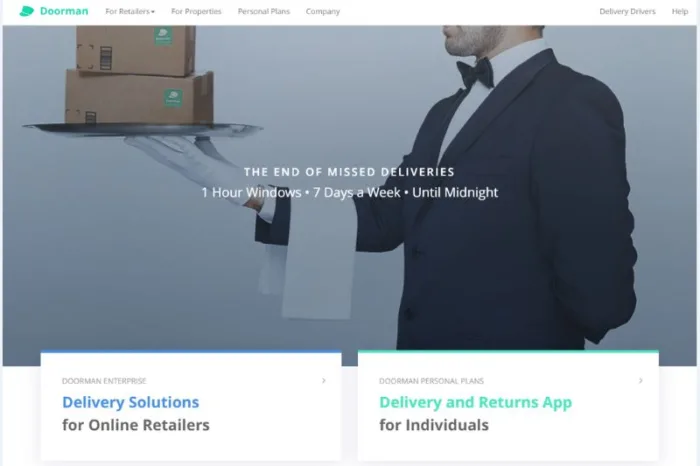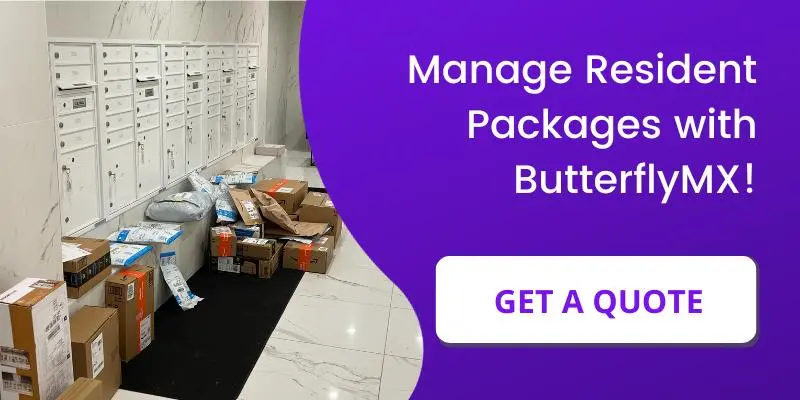Takeaways
- The Doorman app was a package delivery service that allowed consumers to schedule their package deliveries.
- Doorman shut down all operations in 2017 after failing to sustain its business model despite the success of a Shark Tank appearance in 2015.
- Doorman failed because it remained focused on a B2C model for too long and wasn’t able to achieve a high density of package deliveries.

Established in 2013, the Doorman app set out to solve the problem of residents missing package deliveries. Even with significant backing from investors and a successful appearance on ABC’s Shark Tank, the company could not sustain itself long-term. So, what happened to Doorman?
Well, this blog will walk you through what exactly Doorman was and what happened after its appearance on Shark Tank. In addition, you’ll learn how the Doorman delivery app met its fate and the best alternative for a package delivery solution.
This post covers:
- What is the Doorman app?
- What happened to Doorman?
- Why did Doorman fail?
- The best Doorman app alternative
What is the Doorman app?
The Doorman app was a package delivery solution designed to eliminate the problem of apartment residents missing deliveries.
In 2013, founder and CEO Zander Adell believed the last stint of the delivery process could be better optimized. At the time, ecommerce was growing exponentially, so Adell set out to solve the issue of missed deliveries that millions experienced with Doorman’s delivery services.
Doorman started operations in San Francisco in 2014 before expanding to other major cities in the following years. The service offered a subscription with a monthly fee for those wanting unlimited package deliveries. Alternatively, customers could pay a flat rate for every use of the service.
Essentially, Doorman operated by managing its own fulfillment centers in the major cities it served. Then, when a customer purchased an item online, they could set a Doorman warehouse as their delivery location. From there, Doorman would deliver the package at the customer’s requested time.
What happened to Doorman?
Once operational in 2014, the Doorman app raised thousands of dollars in pre-seed funding. Within the same year, Doorman delivered around 4000 packages to residents in San Francisco.
However, Doorman didn’t see significant growth and popularity until 2015, when Adell was invited onto the popular ABC show Shark Tank. In season 6, episode 13, Adell obtained a $250,000 investment from Robert Herjavec in exchange for a 12% stake in the company.
What happened to Doorman after Shark Tank?
After Doorman’s successful Shark Tank appearance, the startup drew significant attention from other investors. In 2015, Doorman raised the funding needed to expand to other major cities like New York City and Chicago. Not to mention, Doorman’s services expanded as well, including same-day deliveries and pick-up services.
Meanwhile, the startup began developing relationships directly with ecommerce brands, such as Casper and Rent the Runway. That way, Doorman could establish a business-to-business (B2B) revenue stream and provide consumers with faster delivery options. Of course, the Doorman app was released for mobile phones in the same year to further benefit consumers.
Is Doorman from Shark Tank still in business?
No. As of 2017, Doorman is no longer in business.
While 2015 was a prosperous year for the startup, Doorman could not anticipate the buying habits of its consumers. In short, Doorman offered customers unlimited deliveries at subsidized prices. And, according to the U.S. Government Accountability Office, Americans have increased their package deliveries to over 50 million a year, effectively overwhelming delivery systems such as Doorman. As such, unlimited deliveries caused customers to order twice as many packages and as a result, Doorman began losing money with every delivery.
So, Doorman responded to the crisis with subscription price hikes – which was initially $19 a month — and eliminated the option of unlimited deliveries. In the end, the Doorman delivery app couldn’t sustain its business model and eventually ran out of capital.
Doorman shut down all operations on October 6, 2017.
Why did Doorman fail?
Ultimately, Doorman failed because it wasn’t able to make a profit from unanticipated consumer behavior. Even with the adjustments made after losing money, Doorman failed to recognize critical points that were vital to its downfall.
Here are some of the ways Doorman could have succeeded:
- Prioritized density and efficiency. Doorman failed to optimize its delivery routes, allowing customers to choose narrow delivery windows even during low-demand times. Focusing on high-density operations to maximize efficiency and reduce costs per service would have helped offset these issues in the future.
- Balanced automation with a human touch. While automation can increase efficiency, the “doorman fallacy” demonstrates the importance of human interaction in customer service. As such, maintaining a balance between automated systems and personalized service could have helped the service.
- Adapted to changing consumer behavior. Doorman struggled to anticipate and adapt to changes in consumer purchasing habits instead of remaining flexible and responsive to evolving customer needs and market trends.
- Invested in robust technology. Software glitches and system failures can significantly impact access control systems. Moreover, they should have prioritized regular software updates, cybersecurity measures, and system maintenance to ensure reliability.
- Conducted regular security audits. To prevent unauthorized access and data breaches, Doorman should have performed frequent security assessments and updated their systems accordingly.
Discover the difference between a package locker and a package room:
The best Doorman app alternative
Choosing an alternative to the Doorman app for package delivery isn’t difficult when you take into account how far package management has come. As such, if you’re looking for a robust package solution that increases efficiency and enhances the tenant experience, then we’re confident you’ll appreciate ButterflyMX’s package room.
Established in 2014, ButterflyMX is an access control company providing building-wide solutions for multifamily properties. Our products are installed in over 15,000 buildings and have more than 40,000 5-star ratings. What’s more, the ButterflyMX package room helps properties easily receive, store, and manage packages. In turn, residents don’t have to worry about missing or stolen packages while away from home.
Here’s how the ButterflyMX package room works:
- A courier delivers the package. At the package room door, a ButterflyMX intercom is installed, where every courier is assigned a delivery PIN. When delivering, the driver inputs their unique PIN to enter the package room. Upon entering the PIN, the ButterflyMX package room intercom takes a time- and date-stamped photo.
- The resident is notified. Once the courier has completed the delivery, the resident is notified via text, email, or in-app that their package was safely delivered.
- The resident retrieves their package. Finally, the resident may use their PIN or mobile phone to retrieve their package. Like couriers, a time- and date-stamped photo is taken upon granted access.
If you’re looking for a scalable solution, the ButterflyMX Package Room pairs well with the ButterflyMX Front Desk Station. The Front Desk Station requires no additional hardware and it monitors all entry events with live video, further diminishing the potential for package theft. The Front Desk Station also allows you to manage and verify the credentials of all visitors and delivery personnel, providing your tenants with a well-rounded experience.






